This post originally published on April 8, 2014. We’ve updated it here with new info, screenshots, and a special episode of the Buffer podcast – The Science of Social Media.
Have you ever found yourself explaining how to use hashtags to someone whose only connection with the word is as a telephone button?
Internet language has evolved considerably over the past few years as social media has taken off. Hashtags are a huge part of this evolution. What once was a telephone button is now a social media phenomenon. No wonder people are curious.
When they ask, I tell them that hashtags are a pound sign immediately followed by a keyword. They’re used for categorization on social media. Yes, they can be annoying if overused. And yes, I’ve seen the hashtag video of Jimmy Fallon and Justin Timberlake.
Hashtags also have the potential to be truly valuable. The stats and info below make a pretty clear case that we should be understanding, using, and appreciating hashtags.
Interested in listening to this post in the podcast format? We invite you to check out an episode on this topic in Buffer’s very own podcast – The Science of Social Media!
Research says you should be using hashtags
If you’re looking for a completely cut-and-dry ruling on the topic of hashtags, then here it is: You should be using hashtags.
The proliferation of hashtags is truly incredible. What began on Twitter has now spread to Facebook, Google+, Instagram, Google search, and almost everywhere in between. (LinkedIn experimented with hashtags for awhile before giving up.)The widespread acceptance of hashtags should give you plenty of reason to consider using them. I also really enjoy the case laid out by Steve Cooper, writing for Forbes.com:
As ridiculous as hashtags might seem to marketing veterans who remember a time before Twitter and Facebook, the younger generation and potential customers/clients don’t. To them, using hashtags is as natural and common as typing their query into the search box.
Not only could people be typing in your hashtag on a Google search, but they could very well be doing it in Twitter, too. In this sense, a hashtag will make your content viewable by anyone with an interest in your hashtag, regardless of whether they’re part of your clan or not.
A hashtag immediately expands the reach of your tweet beyond just those who follow you, to reach anyone interested in that hashtag phrase or keyword.
But how to use hashtags is a different story completely. How do you find the best ones for your content and make sure you’ve got them in the right number, on the right social network? Let’s break it down.
Hashtags on Twitter
Tweets with hashtags get two times more engagement than tweets without.
This data, courtesy of Buddy Media, is one of the most-cited examples of the effectiveness of hashtags, and for good reason: doubling your online engagement is a big deal! Imagine going from four retweets to eight or 10 retweets to 20. And all it takes is a simple # or two?
Apparently so. Although, you’ll want to keep it to no more than two.
Buddy Media’s research also showed that the volume of hashtags bears monitoring : one or two hashtags appear to be the max. When you use more than two hashtags, your engagement actually drops by an average of 17 percent.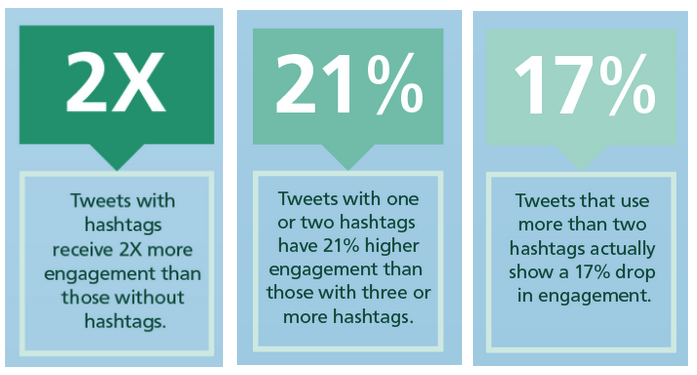
Twitter’s own research into hashtags confirms that there is significant advantage to using them. Individuals can see a 100 percent increase in engagement by using hashtags (the same bump as seen in the Buddy Media study). Brands can see a 50 percent increase.
Engagement, as measured in these studies, can include clicks, retweets, favorites, and replies, yet if it’s only retweets your after, hashtags still would be a smart bet.
Tweets with one or more hashtag are 55 percent more likely to be retweeted.
Dan Zarella discovered this effect in a study on retweeting behavior that included more than 1.2 million tweets. The large scope of the study made for a 99.9 percent confidence interval with the results.
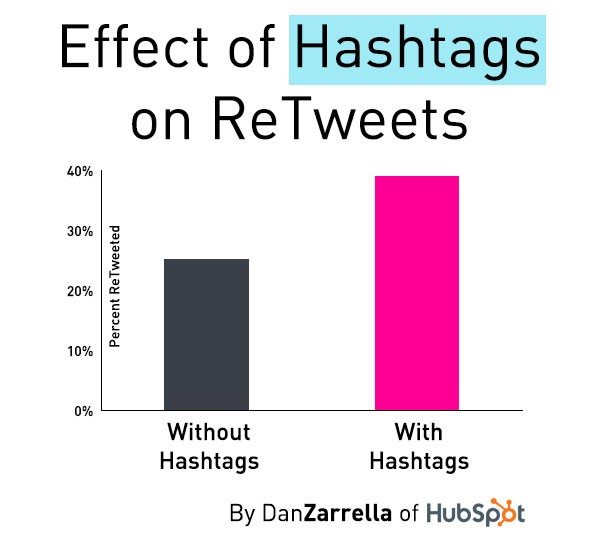
The one caveat to hashtags on Twitter might come for those brands looking to gain clicks on Twitter ads. In the case of advertisements, Twitter found that tweets without a # or @-mention generate 23 percent more clicks.
The reason? Hashtags and @-mentions give people more places to click inside a tweet instead of focusing solely on a call-to-action.
Hashtags on Instagram
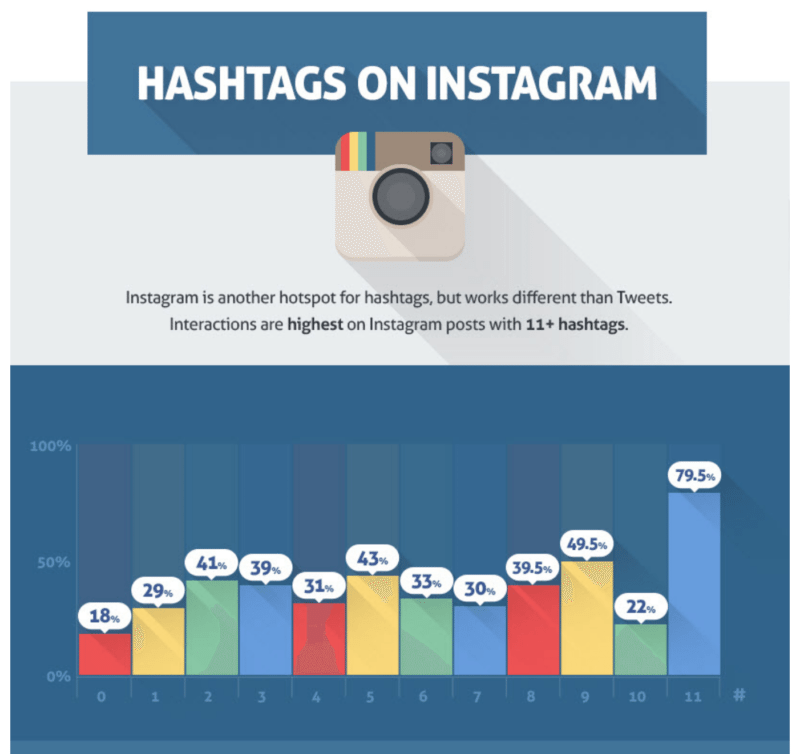
Instagram is another hotspot for hashtags, and the good news for those who love to extensively tag photos is that there doesn’t seem to be a saturation point.
Interactions are highest on Instagram posts with 11+ hashtags.
A rule of thumb could be: Don’t sweat your amount of Instagram hashtags.

The best part about this recommendation is that the data comes from a set of users with 1,000 or fewer followers—a group that likely includes small businesses and those just diving in to Instagram. In other words, hashtags could be your best bet for growing a fast following on Instagram.
The Instagram Shadowban
There has been a lot of talk recently among marketers about what’s called the Instagram Shadowban. Essentially, a shadowban is when Instagram withholds the distribution of your photo or video on Instagram due to “inappropriate content.” Inappropriate content can vary widely, but usually it has to do with the content of the photos or videos themselves or spam-like behavior such as using bots to engage with users or banned hashtags.
Later put together an interesting and insightful guide on how to navigate the Instagram Shadowban in order to keep your account in the green and your photos/videos seen. In that article, Later shares a direct statement from the Instagram team regarding the proper use of hashtags on the platform:
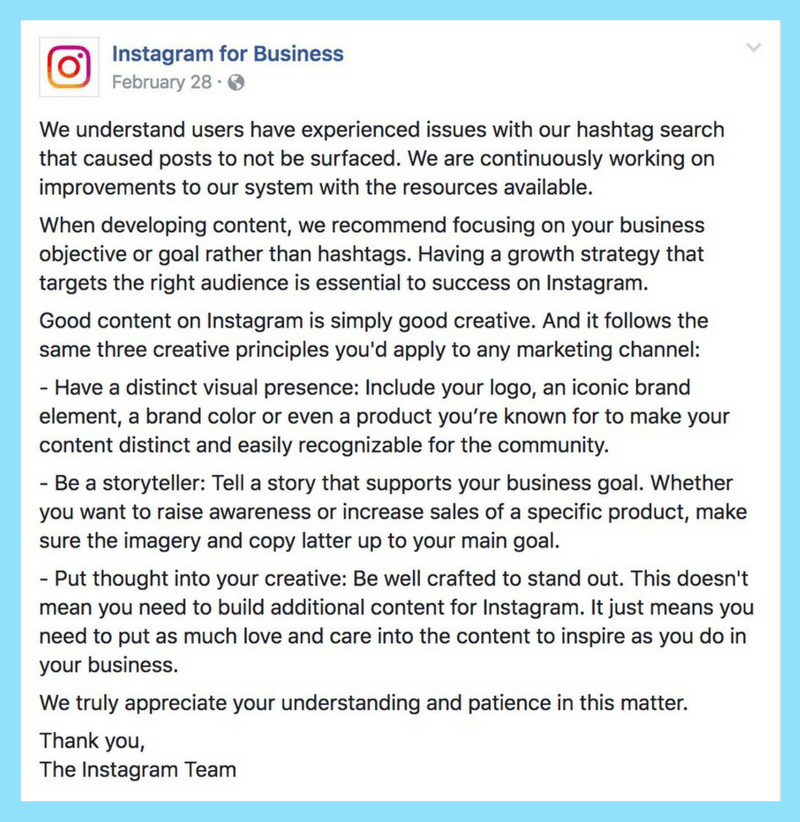
How to avoid shadowbanning on Instagram
Alex Tooby, Instagram expert and influencer, shares her top tips on how to avoid the Instagram Shadowban. Here’s a quick overview so that you can keep your account in the clear today:
- Avoid using banned or broken hashtags in your caption and/or comments
- Avoid using any type of software that violates Instagram’s terms of service
- Avoid any big surges in your Instagram activity (ex., liking or commenting with bots)
- Avoid being reported by users by posting only appropriate content to Instagram
Looking to learn more about the Instagram Shadowban? We cover that and more in this episode of our Buffer podcast – The Science of Social Media!
Hashtags on Facebook
So yes, Twitter and Instagram are clear winners for hashtags. But what about Facebook? Here’s where the recommendation gets a little trickier.
Facebook posts without a hashtag fare better than those with a hashtag.
Hashtags have only been around on Facebook since June 2013, and three months later, research from EdgeRank Checker found that using hashtags on Facebook has zero positive effect on reach. Posts without hashtags outperform those with hashtags.
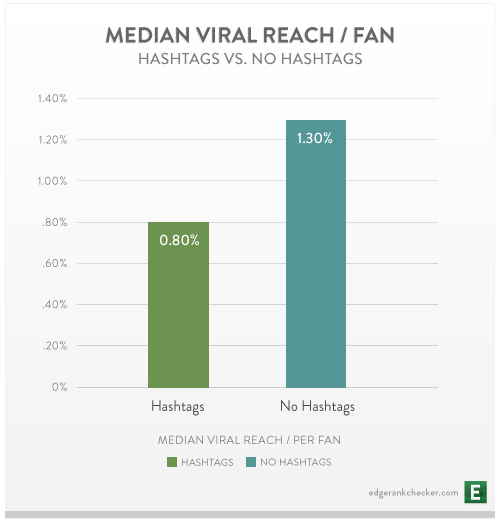
A lot could have changed since September, when this data was first released. Should you abandon hashtags on Facebook solely due to this research? It’s probably best to test. There’s still a lot of analysis left to be done. For instance, Social Bakers studied posts in February of this year and found that using hashtags might not be the main worry, but rather using too many hashtags (just like the advice on Twitter).
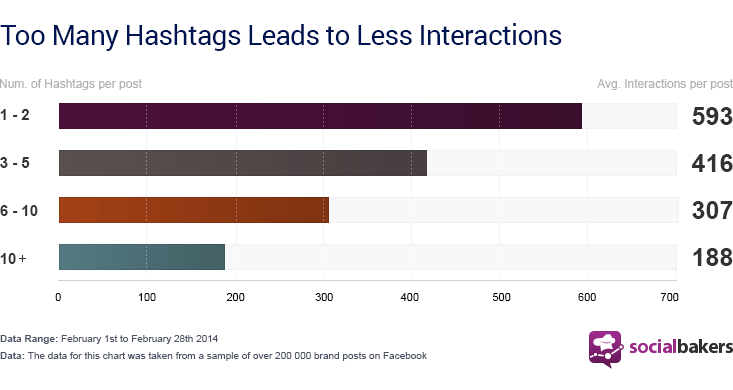
Hashtags on Google+
On Google+, your posts are given hashtags automatically based on their content, but you can also edit them or add your own. Also unique about Google+: You can add hashtags in your comments as well as your post – double the opportunities to be found.
And since Google+ is Google’s social network, hashtags are now built right into Google searches. If you type in a hashtag search, you’ll get the normal search results plus a sidebar of relevant Google+ posts. Hashtags have truly arrived!
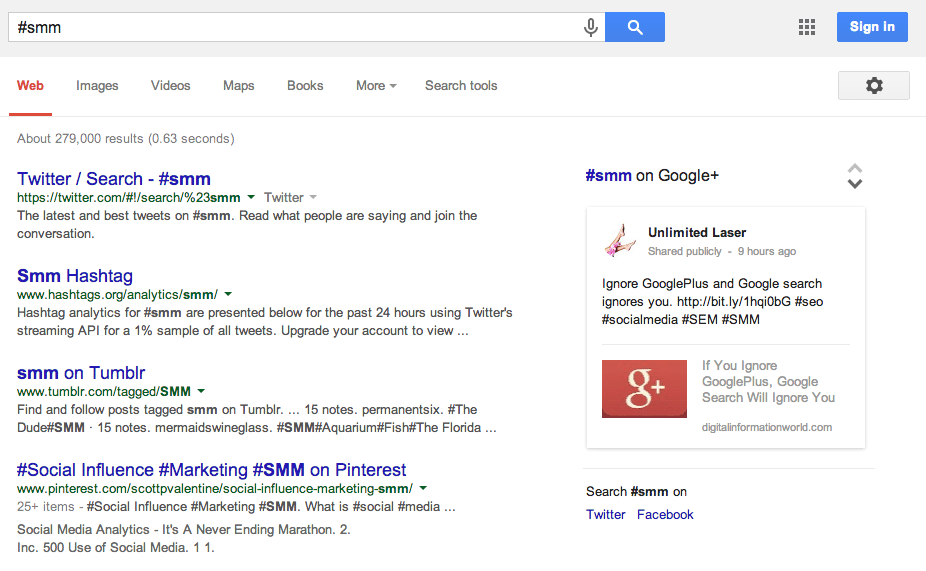
Google+’s “related hashtags” also offer smart marketers a brainstorming opportunity to discover new content ideas and gauge interest level in specific topics.
Tools to find and manage your hashtags
Using the right tools, you can use hashtags as an organization system for your social media campaigns. With everything collected under one hashtag banner, you can see at-a-glance the reach of your campaign and the discussions happening around the topic.
One of the most complete hashtag tools you will find, Hashtagify.me has reams of data you can use to analyze hashtags. The most helpful could very well be the first data you’re shown: related hashtags and their popularity. When you type in a hashtag, the service will show you other hashtags to consider and will display visually how popular each hashtag is and how closely it correlates to the original.
2. RiteTag
RiteTag helps ensure that the tags you use are well-chosen by showing you how good, great, or overused a particular hashtag is. The visual organization of hashtags into colored bars works great for quick analysis at-a-glance.
3.
TagboardWith Tagboard, you can see how your hashtag is used across multiple networks. The results pages on Tagboard show hashtagged posts from Twitter, Facebook, Instagram, Google+, Vine, and App.net
4. Twitalyzer
Though not an explicitly hashtag tool, Twitalyzer does show hashtags as part of its audit of Twitter accounts. Input the username of someone you want to investigate, and Twitalyzer can tell you what hashtags he or she uses most often. This can be really helpful in finding out how your niche’s influencers tweet.
5. TrendsmapLocal businesses might find value in Trendsmap, which shows you relevant hashtags that are being used in your geographic area. (#wrestlemania is a popular one where I am in Idaho.)
4 steps to find the right hashtag to use
Using the tools above, you can hone in on a few ideal hashtags to start with, and like most things online, test and iterate from there.
1. Learn from the best: What hashtags are influencers using?
Twitalyzer can give you a good foundation of where to begin for your hashtag search by showing you how influencers are using hashtags. Grab a handful of usernames of people and brands in your industry whom you admire, and input the accounts into Twitalyzer. At the bottom of the results page, you’ll see a section for their most commonly-used hashtags. Add the relevant ones to your list of potential hashtags.
Let’s say I wanted to find some hashtags to use in promoting social media marketing content. I might start with a list of names like Jeff Bullas, Jay Baer, Mari Smith, and Ann Handley. Here is what the hashtag results on Twitalyzer look like for Jeff Bullas:

Info like this would lead me to start a short list of hashtags like:
- #socialmedia
- #SMM
- #contentmarketing
- #social
- #content
- #marketing
2. Cover all your bases: Are there related hashtags you should be considering?
Armed with an idea list of hashtags, you can then hop into Hashtagify.me to see which related hashtags might also be worth pursuing. While you’re doing this exercise, take note of the circle size on your results: The larger the circle, the more popular the hashtag.
Again, following our social media marketing example, here is what the results page would look like for a search of #socialmedia:
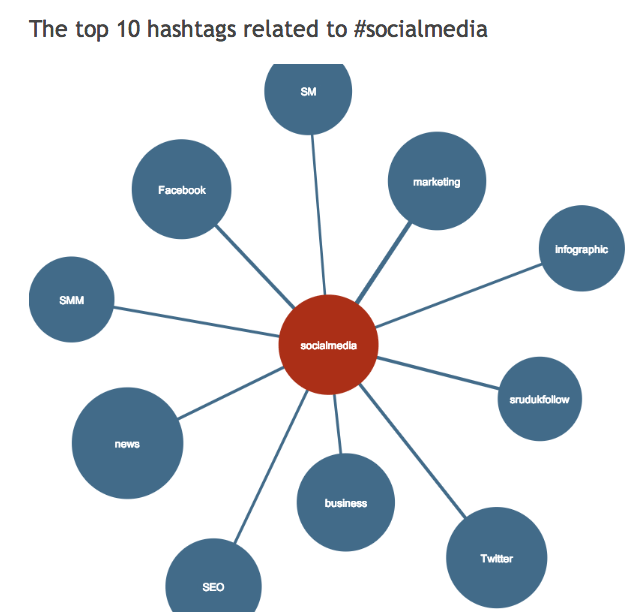
Not every hashtag listed here will be relevant to you, but it does help to see some that you might not have previously considered. In the case of our example, I might add #business, #infographic, and hashtags of specific network names like #twitter and #facebook.
3. Identify the all-stars: Which hashtags are the best to use?
Popularity and volume can be good indicators of the value of your hashtag, but you may wish to go one step further. Hashtagify.me has advanced, premium tools that let you go deeper into statistics on individual hashtags. In a pinch, you can also get some solid data from RiteTag and their visual expression of
how much each tag can boost your post’s reach.Among posts that contain the word “marketing,” RiteTag shows these tags as the most likely to be great, good, or overused. (There’s that #wrestlemania tag again!)

4. Double check: Could your chosen hashtags mean something else entirely?
One last check before you finalize your list of hashtags should be whether or not the hashtag you’ve chosen is being used elsewhere in an entirely different context.
The worst thing that can happen when using a hashtag is to realize after it’s tweeted that the same hashtag is used for an entirely different topic.
Jawbone tried a #knowyourself campaign on Instagram, only to find that the hashtag was already being used generically by thousands of users in all sorts of different contexts. This didn’t necessarily ruin Jawbone’s campaign, but it may have made life a little more difficult for the marketing team.
Takeaways
Hopefully you’ve learned the value of hashtags here and a few neat ideas on how to find some to use in your social sharing. If you’re looking for a simple rule of thumb for hashtagging posts, I think there’s a lot of truth here in this advice from The Next Web:
Rule of thumb: 1 – 3 tags is best over all platforms.
- Twitter: to categorize
- Pinterest: to brand, and be specific (tags are only clickable in pin descriptions)
- Instagram: to build community, and be unique/detailed
- Google+: to categorize; autogenerates tags based on what it thinks your post is most relevant to
- Tumblr: to categorize interests, can be specific and general (has a “track your tags” feature)
- Facebook: sort of a hashtag fail – if your audience is very business-minded, follow Twitter rules; if it is community-oriented, follow Pinterest/Instagram rules
What hashtags do you routinely use on social media? I’d love to hear how you’ve put hashtags to work in your social media strategy.
Image credit:mikecogh, Unsplash, IconFinder,
Try Buffer for free
190,000+ creators, small businesses, and marketers use Buffer to grow their audiences every month.



